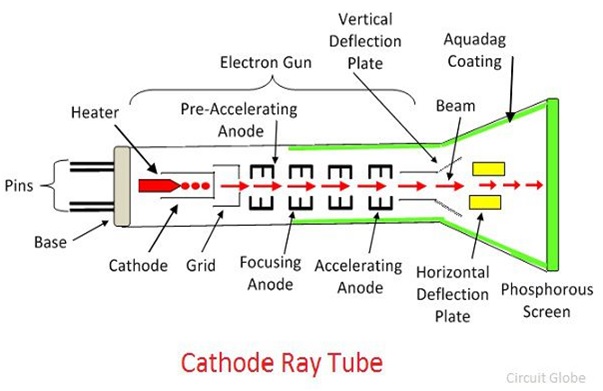Home »
Computer Graphics
Cathode ray tube in Computer Graphics
In this article, we will learn about introduction of the cathode ray tube , components , working, application advantages and disadvantages of cathode ray tube in computer graphics.
Submitted by Prerana Jain, on August 11, 2018
Cathode Ray Tube
Ferdinand Barun of Strasbourg developed the cathode ray tube in the year 1897. It used as an oscilloscope to view and measure some electrical signals. But several other technologies exist and solid state moving may eventually predominate. General a cathode ray tube is s special type of vacuum tube in which some images are produced. The images are generated when an electron beam strikes on the phosphorescent surface. Most of the old types of computer desktop and television display use the cathode ray tube. The CRT used in the computer display is like a picture tube in a television.
In the computer system, there are several modes of computer display or sets of specification on which the CRT operates. The most commonly used specification for CRT display is known as SVGA( super video graphics Array). the laptop uses the liquid crystal display. The technology used in the modern computers and the television of LCD are different.
Components of cathode ray tube
The cathode ray tube can be divided into the three sections:
1. Electron Gun
- The major role of this section is to produce electron at a very high velocity. The whole process is done by a process name thermionic emission.
- The filament present in the cathode tube is heated to a fixed point where the electrons become loose.
- An anode of the high speed is applied to it and the electrons move toward the screen due to electrostatic attraction.
- The brightness of the image is controlled by the electron passes through a series of the control grid.
- If the grid is more negative then the image is darker or vice versa.
2. Deflection system
- The deflection system controls the images which are produced by controlling the position of the electron that hot the screen.
- It consists of two perpendicular set of electric and magnetic fields and it control both the horizontal and vertical axes.
- When the voltage applied to the field is controlled then it is possible to vary deflection through electrostatic force or motor effect.
3. Fluorescent screen
- This screen display where the electrons are hitting the cathode ray tube.
- This screen is coated with a material that emits light when it struck by electrons.
- The two commonly used materials are zinc sulfide or phosphorus.
Application of cathode ray tube
- The cathode ray tube is used to create a moving image.
- The CRT TV works by moving the electron beam scan the screen at a faster rate.
- It is used in the cathode ray oscilloscope.
- It is used as a display device in radar.
- It is used in computer monitors and some television.
Advantages of cathode ray tube
- It operates at any resolution and at an aspect ratio.
- CRT runs at the highest pixel resolution.
- Cathode ray tube produces a very dark black and the highest contrast level.
- CRT is best suited for rapidly moving or changing the image and have a fast response time.
- CRT is less expensive than any other display technology.
Disadvantages of cathode ray tube
- It is relatively bright but not as LCD's brightness.
- Some CRTs are round spherical or cylindrical shapes but new CRTs are flat.
- They are very large heavy and bulgy.
- They also consume a lot of electricity and produce a heat.

Advertisement
Advertisement